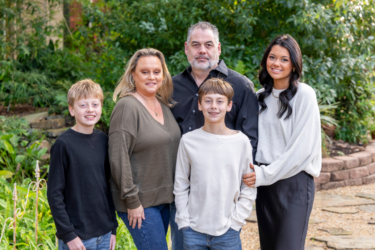Children, like adults, are creatures of habit who take comfort in the familiar—for better or for worse. Although most children’s bad habits are developmentally related and disappear over time, behaviors that persist and are injurious or intensify may need to be addressed. In such cases, experts suggest parents identify the underlying cause, search for a solution and offer lots of support and encouragement.
“When looking at a habit, parents need to remember their child’s behavior has a purpose—it’s serving a need,” said Laura Morris, associate director of a preschool program. “Many children engage in habits for comfort or to help them cope with stress, fear or anxiety. Some do it out of boredom or to get attention. It may even spring from a need developed during infancy that lingers on.”
This was the case with Laura Slavik’s son. Somewhere between his first and second birthday he developed a speech delay. And that’s what triggered the trouble.
“Because he couldn’t communicate, his reaction was to strike out,” said Slavik of her now four-year-old. “Several months later, the speech issue was addressed but the hitting continued and became a habit he used when he was bored, tired, frustrated or wanted something I wasn’t giving him.”
To bring about change, parents often need to be proactive.“Look at the situation when the behavior is occurring and identify what is causing the child to act this way,” Morris said. “Once parents identify a pattern, steps can then be formulated to help the child decrease the need for the behavior and find a more acceptable action to replace it.”
Aside from harmful habits, it may be best to take a wait-and-see approach. “One of the biggest skills we teach is to ignore and notice,” said Wadine Tolaiferro, parent educator. “Ignore any behavior that is not destructive to the child or others, and notice and verbally express behaviors you want to see demonstrated.”
As a young preschooler, Jennifer Gallo’s daughter Emily was an excellent sleeper. However, around age three she started waking up during the night and camping out in the hallway.
“Rather than make a big deal about it, we would casually encourage her to stay in bed all night when we tucked her in,” explained the mother of her now five-year-old. “Then if we found her asleep in the hallway, we’d just wake her up and put her back to bed.”
The habit continued for several months until the family went on vacation, and for no apparent reason Emily abandoned her hallway bedroom. They thought she was back to her prior routine, but their sleep issues were far from over.
“When she was about four, she started waking up in the middle of the night, coming into our room and either curling up at the foot of our bed or stretching out the sleeping bag rolled up in the corner of our room,” Gallo said. “Again we took a passive stance. It wasn’t happening every night, so we just reminded her we’d like her to stay in bed all night but didn’t make a big deal out of it.”
Tolaiferro said one way parents can help their child break a bad habit is to ask them questions such as “Why he thinks the behavior is happening then work together on solutions to bring about change.”
Gallo did this with Emily and decided to simply stash the sleeping bag out of sight. Several nights later, her slumbering daughter came to call. When Emily asked what happened to her sleeping bag, Gallo told her she had put it away because she should be sleeping in her own bed. She then asked her daughter why she thought she needed it and she said, “I’m scared.” “I reminded her there was nothing to be afraid of, then casually walked her back to her room and put her to bed,” Gallo said.
Once the habit has been addressed and steps taken to alter the behavior, use positive affirmation to provide continual encouragement. Rendering rewards may be helpful too. Most important, be consistent with expectations and patient in the process. Remember, new habits must be established before old ones can be eliminated.
Solutions to Bad Habits
Problem with a purpose. Most often habits are developmentally related and with patience will disappear over time. Remember that the behavior has a purpose and is serving a need. Most children engage in habits for comfort or to help them cope with stress, fear or anxiety.
Put it on pause. Some habits warrant a wait-and-see approach as focusing on the behavior may exacerbate the problem and potentially lead to a power struggle.
Identify and address. If the habit persists, is injurious or intensifies with time, it should be addressed.
Undercover investigation. To bring about change, parents need to be proactive. Look at the situation when the behavior is occurring and identify what is causing your child to act this way. What is he getting out of the behavior? Once a pattern has been identified, formulate steps to help decrease the need for the behavior and find a more acceptable action to replace the bad habit.
Ignore and acknowledge. Ignore any behavior that is not destructive and verbally acknowledge behaviors you want to see demonstrated.
Teachable times. Look for teachable moments to talk with your child about his habit. Pick a time when the climate is calm and you aren’t in the midst of the problem. Avoid lecturing, scolding, ridiculing or criticism as this could cause the behavior to escalate.
Positive charge. When discussing the habit with your child, state clearly and positively the behaviors you want to see. Instead of saying, “Don’t forget your homework again,” say, “Remember your homework tonight.” When you see desired behaviors offer praise.
Search yourself. Sometimes parents enable behaviors to persist by saying one thing and doing another. If, for example, you tell your child not to interrupt while you are talking with others but let him slip in a quick, “Can I just go to…?” statement and give an answer, this encourages the undesirable behavior.
Dole out distractions. If your child is sucking his thumb out of boredom, give him something to do with his hands—help make cookies, color or play with clay.
Communicate and collaborate. If your child is old enough, get his input on how to break the habit. Ask why he thinks the behavior is happening and then work together on solutions to bring about change. This will give him a sense of empowerment.
Render rewards. Provide incentives for small steps taken toward breaking a habit. Look for nonmaterial rewards your child will enjoy—painting her finger nails, playing catch with Dad, taking a trip to a restaurant with mom.
Rack up resources. Age-appropriate books, videos and other resources are a way to help your child understand undesirable behaviors in a non-confrontational way.
Detail delays. Parents may need to wait until their child is interested in changing the behavior before he can be helped. Sometimes children need to feel the consequences of their actions before they are ready to change.
Conduct with consistency. Breaking old habits takes time, repetition and support from parents. New habits must be established before old ones can disappear.
Model the mold. Children often follow their parent’s lead. Role model and teach desired habits that will contribute to your child’s overall healthy development from the start.
Determine the danger. If the behavior is dangerous to your child or others, is affecting his relationships or is getting in the way of healthy child development, talk with your pediatrician or other professional.





